Prien
Alfred G Prien MM 2c
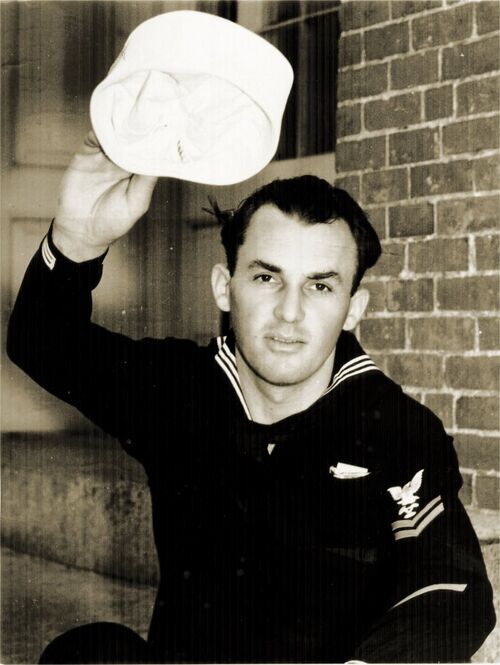
Alfred Gustave Prien was born on July 2, 1912, his father, Gustav, was 28 and his mother, Katharine, was 33.
Alfred had two sisters. The older was Katherine, two years older and named for their mother, and Helen, who was two years his junior. He also had two brothers Howard and Edward.
His parents had emigrated from Hamburg, Germany in the early part of the century. In the 1920's Gustav owned a blacksmith shop in Newman, California but by 1930 census he was a poultry farmer in Sonoma, California. In the 20's the family employed a housekeeper named Jeanette Clark who had a son Gilman who lived with the family.
Nothing is known of his growing up but we assume he graduated school and perhaps worked with his father in the poultry business until he enlisted in the Navy at age 20, seven days after his birthday on July 19, 1932. He reenlisted on September 15, 1938 in Washington D.C.
His basic Navy service record is unknown until he is shows up on a Report of Changes manifest for the submarine tender USS Holland (AS-3) on January 31, 1939 to be transferred from the submarine base at Coco Solo, Panama to the transport ship USS Chaumont (AP-5). He had received orders on January 16, 1939 to report to the new submarine USS Squalus (SS-192) under construction at the Portsmouth Navy Yard. The Squalus was commissioned on March 1, 1939.
The Squalus had been conducting sea trials and had completed a series of 18 successful test dives, training the crew on procedures of operating this particular submarine. On the 19th dive, men were at their stations and going through the rig for dive process.
The first 50 feet of the dive went well according to naval architect Harold Preble who was aboard for the tests. This was the fastest crash dive he had ever clocked. It was at this point all started going wrong.
According to testimony given by Machinist Mate Allan Carl Bryson, who was on the battle telephone, he heard an unidentified voice on the phone system from the aft of the submarine say; "Taper up. Induction open." A few seconds later the same voice said; "Engine room flooding." These words, reported by Bryson, were taken as absolute testimony to what was happening aft on that fateful day. It was later learned that the voice had been of Seaman Alexander B. Keegan who been manning the phone system in the engine room.
Asked by the court of inquiry as to the type of men that made the crew of the Squalus, Preble stated that; "During the sea trials I had observed that they were very well trained and the entire crew knew the functions and operations of the submarine."
All the hull openings, including the Main Induction valve had switches and indicators that showed the physical position of each valve and hatch on the submarine. Whether it was open or closed was displayed via a red or green light on a panel called the "Christmas Tree" in the control room.

The man on that panel that day was Machinist Mate 2nd Class Alfred Gustav Prien. Through months of testimony Prien was firm in his assertion that the Christmas Tree had shown green lights, meaning all the openings were closed before he opened the vents. Chief Torpedoman's Mate Roy H. Campbell also stated that he saw an all "green board".
Once it was known that flooding was occurring Prien again pulled the Main Induction valve lever all the way out to ensure the valve was closed. When the boat touched the bottom he slipped a padlock into place that would have held the valve closed. He did not lock the padlock. The lock was still there after the salvage.
LT William T Doyle, the Diving Officer, reported a green board and this was reported back to him by two other officers that it was indeed a green board before the order to dive was given.
Of the men aboard, 26 aft were to die as the submarine flooded. Water was still leaking into the Control room and forward battery. The disconnects to the battery were pulled to prevent fires and explosions and the remaining 33 men crowded into the forward torpedo room. The long wait began.
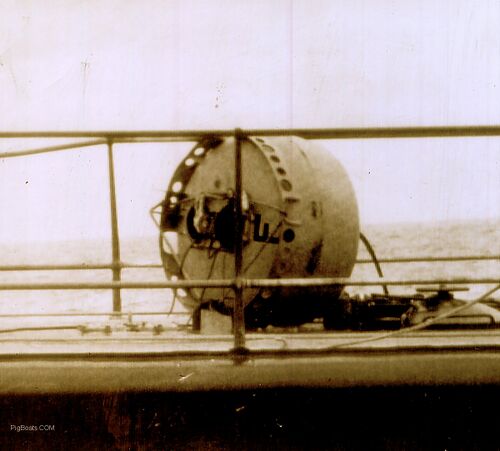
The newly installed messenger buoy was released. It was brightly painted and contained a telephone so the submarine could be talked to by the finder.
Squalus was initially located by her sister ship, USS Sculpin (SS-191). The two submarines were able to communicate using the telephone marker buoy until the cable parted. Divers from the submarine rescue ship Falcon began rescue operations under the direction of salvage and rescue expert Lieutenant Commander Charles B. "Swede" Momsen, using the new McCann Rescue Chamber.
The crew were rescued in four trips of the chamber. Alfred Prien was in the third trip to the surface with eight other shipmates. Trips 1 and 4 each had seven crew and trips 2 and 3 each had nine men aboard. There were supposed to be eight men in each trip but in the dark counting was off one each way.
The men were taken to the hospital and were treated if necessary and examined before they were released.
After the long inquiry and testimony, the men were reassigned. It seems that Alfred Prien was reassigned to the USS R-2 (SS-79) operating as a submarine school training boat out of Submarine Base New London. A muster list dated November 30, 1939 shows that he was formally transferred from the Squalus to the R-2 for duty on November 20, 1939.
On February 16, 1940, Alfred Prien was promoted from a MM 2c to a MM 1c and was still aboard the R-2 at New London.
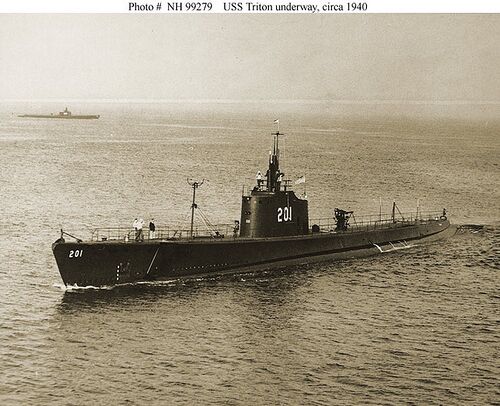
Four months later on June 12, 1940 Prien got orders back to Portsmouth and to the crew of the new submarine USS Triton (SS-201). Triton was commissioned two months later. Sea trials and shake down cruises, training exercises, and mine laying drills kept Triton in the Portsmouth area until July 1, 1941. It was then that he was to meet his future bride, Mary Marconi who lived in Portsmouth, NH.
Triton with Alfred aboard was at sea off Wake Island when WW II started and on the 10th of December, 1941 the submarine made an attack on a Japanese destroyer with four stern fired torpedoes. There was one explosion but no record of damage or sinking is recorded. She returned to Pearl Harbor shortly after.
On March 31, 1942 Prien was transferred to the relief crew of Submarine Division 62 for further training.
On May 24, 1942 he sailed on the transport USS Henderson (AP-1) for San Francisco for a new construction boat, the newly built USS Sunfish (SS-281), at the Mare Island Navy Yard. While aboard Sunfish he extended his enlistment for 3 years and he is also mentioned as now being a Chief Machinist's Mate.
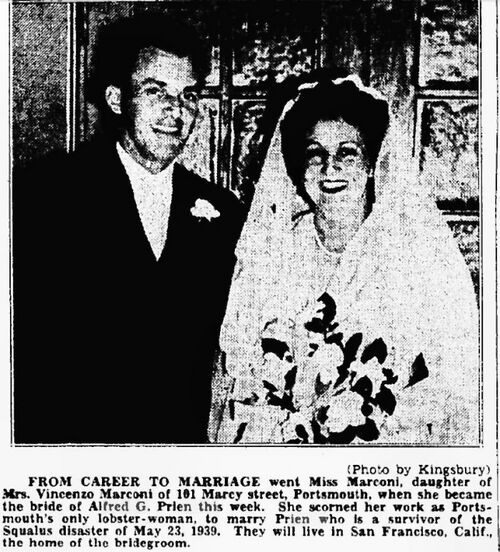
Alfred was married to Mary Marconi on June 22, 1942, in Portsmouth, New Hampshire. This cut short his bride's profession as Portsmouth's only "lobsterwoman"!
Mary Marconi was being taught the trade of catching lobster from her older brother William who was expected to be called into the service at any time. With the marriage the couple changed their address to San Francisco, California, Alfred's home state. He returned to the Sunfish on July 15, 1942. On March 31, 1943 he is still listed as crew on the Sunfish. He was to make three war patrols aboard.
On March 11, 1944 he is transferred back to Portsmouth for the newly built USS Queenfish (SS-393). On May 3, 1944 Prien was released from the hospital at Portsmouth to return for duty on the Queenfish. What he was in for and for how long is still to be discovered. I'm sure while back there he got some time to be with his wife who had moved back to be with her parents while Alfred was away on patrol.
During the war Mary Prien, after moving back to Portsmouth, had joined a club, the Admiral Wainwright Navy Wives Club, that was active in Portsmouth. In January, 1945 she was elected as a Master-At-Arms. In December 1944 the club had put on a Christmas Party for children and adults in town while their husbands were off to war.
It was announced in the newspapers on June 13, 1945 that Alfred had been given a letter of Commendation by Fleet Admiral Chester Nimitz for meritorious conduct in action as a member of the crew of a U.S. submarine, (possibly the Queenfish), There also seems to have been a ribbon given with the letter. The letter states: "His exceptional skill, efficiency, and devotion to duty greatly assisted his commanding officer in conducting attacks which resulted in the sinking of approximately 50,000 tons of enemy shipping. His calm manner and exceptional ability contributed materially to the success of his vessel."
The article also states that by this time he and Mary have a daughter named Antoinette.
At some point in the war Prien changed his rate to Engineman.
On December 1, 1945 Prien is reported as being aboard the USS Trepang (SS-412) at San Diego. Trepang decommissioned on June 27, 1946 and Prien was transferred to the tender USS Nereus (AS-17). Prien retired from the Navy in 1947 and returned to Portsmouth, NH to be with his wife.
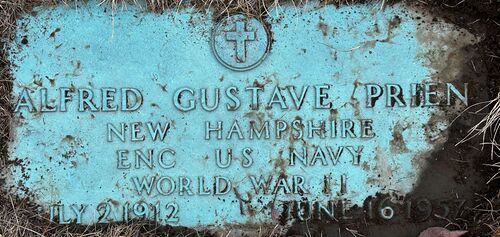
Courtesy of Find A Grave.com
The couple bought property on Broad Street in Portsmouth and settled down to raising their family. Mary was involved in the Brownies and later Girl Scouts. Alfred was a member of the Fleet Reserve and Sub Vets of WW II. In total the couple had three children, a boy named Vincent and two girls, Antoinette and Katherine.
On an outing with friends and family on Fathers Day June 17, 1957, where the temperatures in the North East reached well over 100 degrees, the boat Alfred and another male friend were riding in capsized during a tight turn and the men fell out. The boat righted itself and the engine was still running. The boat, uncontrolled, spun around and came back at the men. The friend grabbed the bow and held on. Alfred managed to get a hold of the side of the boat at the back and hang on but the wash from the boats spinning propeller sucked his legs into it severely cutting and damaging his legs. Alfred let go in shock and pain. The friend swam to him and saved his life by keeping him afloat.
The town's Chief of Police was witness to the accident and radioed for help. Alfred and friend were pulled to shore by a family member in another boat and the Police Chief loaded him in the patrol cruiser and raced to the hospital. They were unable to save his life.
Alfred was 44 years old, just shy of his 45th birthday. He had survived the sinking of the Squalus and had had many war patrols in submarines against a fierce enemy in World War II only to fall victim to an unfortunate accident in a pleasure boat during a happy time with family and friends.
Alfred Gustave Prien was buried at Calvary Cemetery in Portsmouth, New Hampshire on June 19th, 1957 with full military honors.
Page created by:
Ric Hedman & David Johnston
1999 - 2023 - PigBoats.COM©
Mountlake Terrace, WA, Norfolk, VA
webmaster at pigboats dot com
